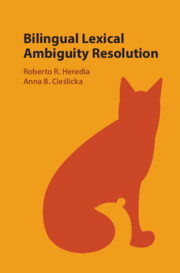Book contents
- Bilingual Lexical Ambiguity Resolution
- Bilingual Lexical Ambiguity Resolution
- Copyright page
- Dedication
- Contents
- Figures
- Tables
- Contributors
- Preface
- Acknowledgments
- Part I Theoretical and Methodological Considerations
- 1 The Cross-Modal Lexical Priming Paradigm and Bilingual Exhaustive Access
- 2 Theory Visualizations for Bilingual Models of Lexical Ambiguity Resolution
- 3 Bilingual Lexical Access
- Part II Bilingual Lexical Processing
- Part III Bilingual Sentence Processing
- Part IV Neuroscience of Bilingual Lexical Access
- Author Index
- Subject Index
- References
2 - Theory Visualizations for Bilingual Models of Lexical Ambiguity Resolution
from Part I - Theoretical and Methodological Considerations
Published online by Cambridge University Press: 24 December 2019
- Bilingual Lexical Ambiguity Resolution
- Bilingual Lexical Ambiguity Resolution
- Copyright page
- Dedication
- Contents
- Figures
- Tables
- Contributors
- Preface
- Acknowledgments
- Part I Theoretical and Methodological Considerations
- 1 The Cross-Modal Lexical Priming Paradigm and Bilingual Exhaustive Access
- 2 Theory Visualizations for Bilingual Models of Lexical Ambiguity Resolution
- 3 Bilingual Lexical Access
- Part II Bilingual Lexical Processing
- Part III Bilingual Sentence Processing
- Part IV Neuroscience of Bilingual Lexical Access
- Author Index
- Subject Index
- References
Summary
Connectionist models describe the human language system as a high-dimensional state space composed of a neural network in which layers of processing units for different aspects of a linguistic signal (visual or acoustic features, orthography, semantics, etc.) interact with one another. Lexical ambiguity emerges when there is conflicting input within or between processing layers. Bilingual connectionist models, such as the bilingual interactive activation (BIA) and bilingual interactive activation plus (BIA+) models, treat bilingualism as the inclusion of new dimensions into this network, resulting in new opportunities for conflict, such as interlingual homonyms and cognates. We outline connectionist accounts of lexical ambiguity resolution in monolinguals and bilinguals, which we visually depict as movement through a multidimensional state space.
Keywords
- Type
- Chapter
- Information
- Bilingual Lexical Ambiguity Resolution , pp. 17 - 41Publisher: Cambridge University PressPrint publication year: 2020



